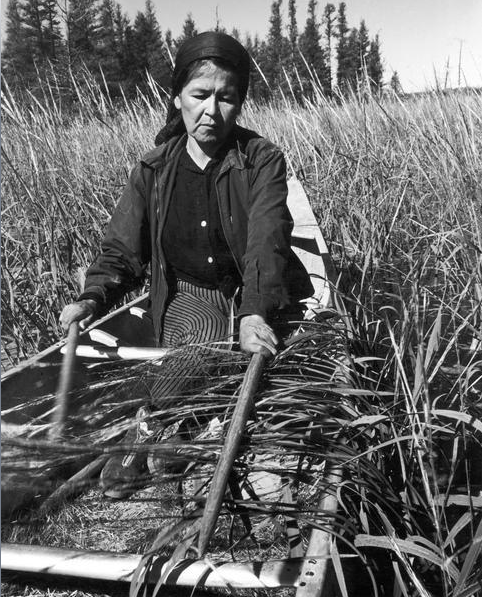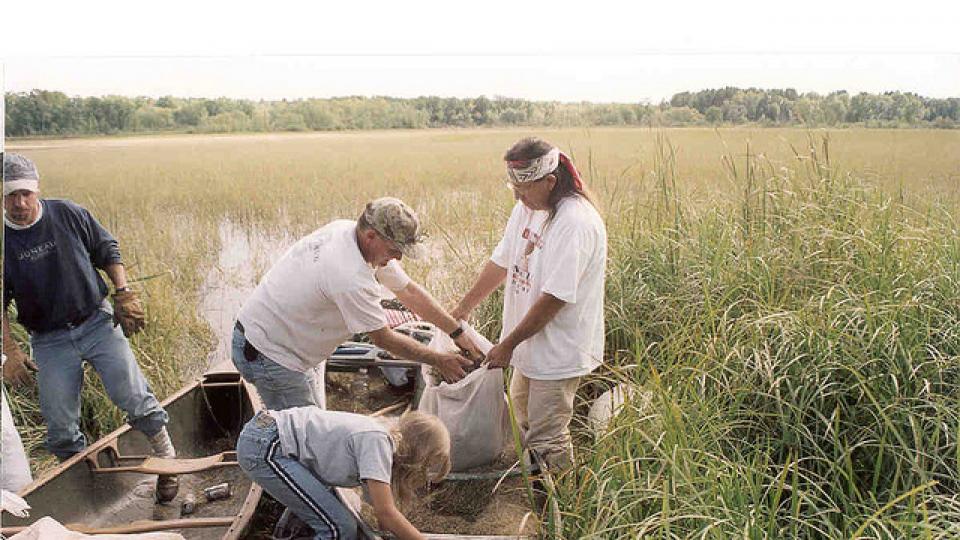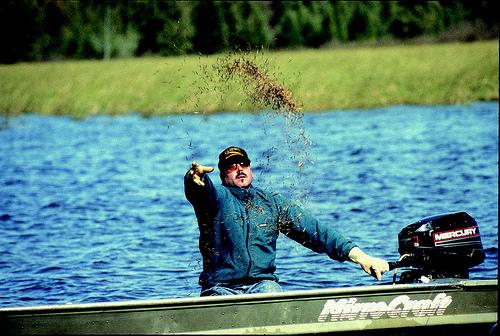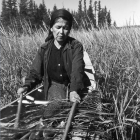
A woman in northern Wisconsin harvests and knocks wild rice off the stems into her canoe using traditional harvesting sticks.
A woman in northern Wisconsin harvests and knocks wild rice off the stems into her canoe using traditional harvesting sticks.
Courtesy of Wisconsin Historical Society
 This work is licensed under a Creative Commons Public Domain Mark 1.0 License.
This work is licensed under a Creative Commons Public Domain Mark 1.0 License.
According to oral tradition, the Anishinaabeg people, also known as Ojibwe or Chippewa, followed a shell in the sky thousands of years ago to find a place where food grows on water. Their journey led them from the east coast of the United States to the Great Lakes region, which encompasses parts of both the United States and Canada that surround the five Great Lakes, including eight US states and the Canadian province of Ontario. It is named after the Great Lakes basin, the geological formation underlying the watershed of the lakes.
They settled in the Great Lakes area because of wild rice (Zizania), which grows in lakes and thus fulfills the prophecy. In fact, it is the only grain native to North America. Known to the Anishinaabeg as manoomin, meaning the “good berry”, it became a spiritual and cultural staple as well as a culinary one. Wild rice is an important food source for people and wildlife such as the waterfowl. It is used medicinally, by mixing herbs in cooked rice to make poultices. It is also widely used as a spirit offering for ceremonies such as funerals. To express gratitude to the spirit provider for the gift of wild rice, people give offerings of thanks and act as respectful stewards of this valuable resource. For these reasons, some Anishinaabeg communities believe strongly that wild rice should be a wild harvested food, not a cultivated crop.
However, not everyone feels the same. The University of Minnesota first became interested in domesticating wild rice in the late 1800s, after anthropology professor Albert Jenks studied wild rice practices on Anishinaabeg reservations. He dismissed their harvesting techniques as primitive and stifling economic development for the tribes. In the mid-1950s, another staff researcher, Ervin Oelke, intentionally collected germ plasm from twenty-four wild rice beds in lakes used by Anishinaabeg people. This plant material served as the basis for the university’s Agricultural Extension office to create and release nine strains of wild rice for cultivation between 1968 and 2000. Unlike foraged wild rice, cultivated wild rice is bred to ripen simultaneously and to be harvested by combine. This allows producers to grow hectares of wild rice just like any commodity agricultural crop, with great efficiency and high yields. Minnesota farmers quickly adopted growing this grain, destabilizing the Anishinaabeg economy that had been based on selling foraged wild rice to food companies. By the mid-1980s, the vast majority of wild rice harvested in the country was cultivated. After lawsuits and hard feelings, the Anishinaabeg and the University of Minnesota established a consortium that meets regularly to discuss cultural sensitivity and research ethics surrounding resources of tribal cultural importance, including wild rice.

Minnesota residents harvest wild rice from a lake.
Minnesota residents harvest wild rice from a lake.
© Eli Sagor 2007.
Click here to view Flickr source.
The copyright holder reserves, or holds for their own use, all the rights provided by copyright law, such as distribution, performance, and creation of derivative works.
Despite differences in its production and genetic makeup, there are similarities between paddy wild rice and “true” wild rice. Red-winged blackbirds, ducks, and other wildlife that eat rice do not distinguish between them. Brown spot, the most serious wild rice disease, affects both in equally damaging ways. Rice worm, the most serious pest of wild rice, also damages both. Most recently, both wild rice harvesters and wild rice growers are concerned that climate change effects will devastate rice lakes and beds due to increasingly frequent and extreme weather events.

Staff members of Great Lakes Indian Fish and Wildlife Commission seeding wild rice beds to increase plant populations in northern Wisconsin.
Staff members of Great Lakes Indian Fish and Wildlife Commission seeding wild rice beds to increase plant populations in northern Wisconsin.
US Department of Agriculture photo.
 This work is licensed under a Creative Commons Public Domain Mark 1.0 License.
This work is licensed under a Creative Commons Public Domain Mark 1.0 License.
Foraged wild rice face even more threats. Water pollution from urbanization and mining ore can destroy wild rice beds. Invasive species, such as Asian carp, can also alter lake ecosystems and cause rice populations to crash. Finally, genetic contamination of “true” wild rice strains may occur, as genetically engineered rice cultivated in paddies near lakes can hybridize with wild rice strains through wind pollination.
In light of these economic and environmental challenges that disproportionately impact foraged wild rice, the Anishinaabeg have changed their management practices. The tribes routinely restore lake habitats and seed wild rice beds to ensure there is a harvest to be had the next year. They also remove beaver dams, which would otherwise eventually fill in the lakes. Yet the future of manoomin remains uncertain, as tribal agencies attempt to work with federal, state, and local agencies to procure the capital and human resources necessary to sustain the culinary and cultural staple of the Anishinaabeg people.
How to cite
Stack Whitney, Kaitlin. “Manoomin: The Taming of Wild Rice in the Great Lakes Region.” Environment & Society Portal, Arcadia (2015), no. 2. Rachel Carson Center for Environment and Society. https://doi.org/10.5282/rcc/6830.
ISSN 2199-3408
Environment & Society Portal, Arcadia
 This work is licensed under a Creative Commons Attribution-NonCommercial-ShareAlike 4.0 International License.
This work is licensed under a Creative Commons Attribution-NonCommercial-ShareAlike 4.0 International License.
2014 Kaitlin Stack Whitney
This refers only to the text and does not include any image rights.
Please click on the images to view their individual rights status.
- Hassel, Craig. “Woodlands Wisdom: A Nutrition Program Interfacing Indigenous and Biomedical Epistemologies.” Journal of Nutrition Education and Behavior 38, no. 2 (2006):114–120.
- LaDuke, Winona. “Ricekeepers.” Orion Magazine, 25 June 2007.
- Oelke, Erivin. “Wild Rice: Domestication of a Native North American Genus.” In New Crops, edited by J. Janick and J.E. Simon, 235–243. New York: Wiley, 1993.
- Vennum, Thomas, Jr. Wild Rice and the Ojibway People. St. Paul: Minnesota Historical Society Press, 1988.








